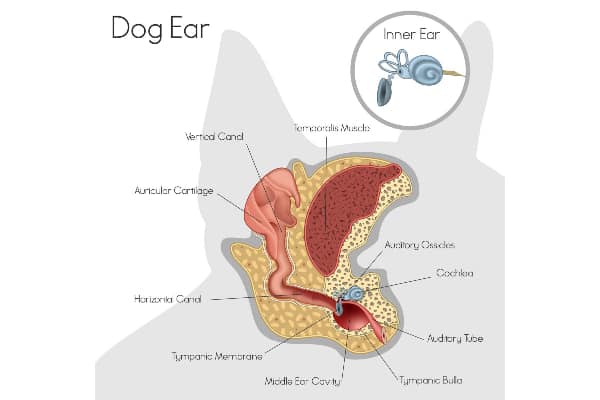If your dog is staggering, stumbling, or falling over, it may be the result of a variety of medical issues, including injury, stroke, poisoning, or an infection. Here, our Matthews Emergency and Specialty Vets explain why you should get to a veterinary hospital right away.
If you notice that your dog suddenly loses their sense of balance they could be suffering from any of the following health issues. Signs of loss of balance should not be ignored since they can indicate a serious medical emergency. If your dog shows signs of any of the following health issues its time to head to the vet straight away.
Ataxia is a condition relating to sensory dysfunction that results in a loss of coordination in the rear end, head, or limbs. Three kinds of ataxia are commonly seen in dogs: vestibular, cerebellar, and sensory.
Vestibular ataxia is the result of an issue with the inner ear or brainstem. Cerebellar ataxia occurs when the cerebellum is damaged. Sensory ataxia is when the spinal cord becomes compressed due to a bulging intervertebral disk or a tumor.
As well as staggering, stumbling and falling over, signs of ataxia include flicking of the eyes from side to side, head tilt, walking in circles, vomiting, and nausea.
Inner ear infections are a common cause of balance loss in dogs. If your dog has an ear infection, you may also notice additional symptoms like head shaking and scratching, walking in circles, and eye flicking, as well as redness, swelling, discharge, and odor in or around the affected ear.
Head trauma, injury or damage to the inner ear can cause balance issues in dogs. It can be difficult to tell if a dog is injured because dogs tend to be very good at masking pain. Signs and symptoms of pain in dogs include heavy panting, slowed reflexes, change in appetite, enlarged pupils, biting or licking the wounded area, reluctance to lie down, and anxiety.
Strokes in dogs are fairly uncommon, nonetheless, they can happen. A stroke can be the result of blood clots, high blood pressure, hemorrhage, head trauma, kidney disease, or migrating worms. Signs that your dog may be having a stroke include loss of balance, head tilt, circling, loss of vision, and collapse.
Sometimes brain tumors will occur in dogs, particularly senior dogs, and can lead to a general loss of balance, staggering, and stumbling. Other symptoms of a brain tumor depend upon the location of the tumor, and include changes in behavior and/or appetite, seizures, signs of pain, head tilt, swaying, a wide stance, lack of coordination, head tremors, pacing, and flicking of the eye.
Encephalitis or inflammation of the brain, can cause dogs to stagger, stumble, or fall over. Brain inflammation can result from a number of issues including fungal infections, tick-borne diseases, and parasites. Other symptoms of encephalitis include depression and fever.
Copyright © 2022. All Rights Reserved. Part of the PetVet Care Centers Network. Managed with Tymbrel
Ataxia in dogs: an uncoordinated gait
When I see a dog who is wobbly and off balance, I think of the word ataxia. This is the medical term for an uncoordinated gait. Ataxia is classified based on which structure in the nervous system is affected—the cerebellum, the spinal cord, or the vestibular system.
The cerebellum is the small part of the brain that sort of looks like a walnut. It sits just behind the cerebrum (large portion of the brain responsible for learning and memory).
The cerebellum plays a role in balance, posture, and coordination of voluntary movements. Thus, damage to the cerebellum impairs these functions.
Signs of cerebellar ataxia in dogs may include:
Causes of ear infections in dogs
Otitis interna (inner ear infections) and otitis media (middle ear infections) can be caused by:
Sometimes, external ear infections can extend into the middle and inner ear. In those cases, affected dogs will also show signs of external ear infections. These include debris in the ear canal, head shaking, or ear scratching. Other times, the external ear canal will be completely normal.

A variety of conditions can affect the brain or brainstem, causing central vestibular disease. Affected dogs tend to have vertical nystagmus (eyes moving up and down) rather than horizontal.
In addition to the other symptoms of vestibular syndrome listed previously, they may have impaired or dull mentation. This means they are slow to process information or respond to stimuli, are unaware of their surroundings or are not acting like themselves. Seizures may also occur.
Infection, inflammation, or brain tumors (tumors of the brain or brainstem) are the most common reasons for a dog to develop central vestibular syndrome signs. Infections may be caused by bacteria, fungi, viruses, or protozoa. Many of these same causes can also affect the cerebellum, causing cerebellar ataxia.
Sometimes a dog will be wobbly and off balance and show other vestibular signs that are not related to hypothyroidism in dogs, tick-borne diseases in dogs, or any of the other causes discussed above. We call this idiopathic vestibular disease. The other name for it is old dog vestibular disease because it happens more commonly in older dogs.
In fact, it also happens to be the most common cause of vestibular disease overall. The good news is that signs often resolve over a period of a few days with supportive therapy. So if there is a “good” type of vestibular syndrome, it is this one.
To learn more about old dog vestibular disease, please refer to my article, Old Dog Vestibular Disease: A True Story About Doggy Vertigo. Also, if your dog has been diagnosed with any of the causes of vestibular disease, you might find these 10 Tips and Exercises for Dogs with Vestibular Disease helpful.
While strokes are less common in dogs than in humans, they do still happen occasionally. Strokes occur when blood flow to the brain is disrupted due bleeding or an obstruction in a vessel. Without the oxygen, glucose (fuel for the brain), and other blood components, the brain doesn’t function correctly. As a result, a dog may be wobbly and disoriented or show other vestibular syndrome signs.

You can read my article, Dog Stroke Symptoms & Treatments in Senior Dogs to find out more.
Anything that damaged or disrupts the spinal cord can cause spinal ataxia. This is the case in IVDD (intervertebral disc disease) in dogs. In this condition, disc material leaves its normal position between two vertebrae (bones in the spine) and starts to press on the spinal cord.
When the spinal cord is compressed, nerve signals have trouble moving past the affected area. In some cases, a vet may recommend IVDD surgery for dogs. Other times, non-surgical IVDD recovery in dogs is possible.
Spinal stroke in dogs is another condition that may cause a dog to be wobbly and off balance. The other name for this condition, fibrocartilaginous embolism (FCE), gives a clue about how it occurs.
A piece of intervertebral disc material (a fibrocartilaginous substance) breaks off and blocks one of the blood vessels that nourishes the spinal cord. When blood supply is obstructed (i.e. an embolism occurs), the portion of the spinal cord supplied by that vessel is damaged.
Some ataxic or disoriented dogs have external injuries that might point to a known or suspected traumatic event as the cause of the signs. The brain and spinal cord can be damaged by :

Head trauma causes damage to the neurons and bleeding and swelling in the brain. If there is swelling in other parts of the body, it isn’t as big of a deal. For example, a leg has space to expand outward when it swells. Not so much with the brain since the skull is a fixed size.
As the brain swells and blood builds up around the brain, the pressure in the skull (intracranial pressure) increases, compressing the brain tissue. This makes it harder to get the blood through the vessels in the brain.
Without the blood supplying needed nutrients and oxygen, brain function declines and the dog may become depressed or disoriented. Cerebellar and/or vestibular ataxia will also occur if either of those systems are damaged.
Spinal cord trauma will cause spinal ataxia since the neurons are damaged by the initial injury and the body’s response to the injury. In severe cases, the dog may even be paralyzed.
Lastly, a variety of toxic substances can cause a dog to be wobbly and off balance. They may also cause other neurologic signs like seizures or tremors, as well as heart, lung, kidney, liver, or gastrointestinal signs.

Toxins to suspect include:
Other toxins not on this list are also capable of causing neurologic signs and some intoxications may be fatal. Anytime you suspect your dog may have ingested a toxic substance, immediately contact your veterinarian or the ASPCA Animal Poison Control Center. (Please note, there is a consultation fee charged for the ASPCA’s services.)
Why is my dog wobbly and off balance? 7 common culprits
Now that you understand the different types of ataxia, we can start to address the seven reasons why a dog is wobbly and off balance.
Before we start talking about ear infections in dogs, we need to review some ear anatomy.
The external ear is the portion that you would see if you peered into your dog’s ear. It is L shaped, and ends at the eardrum (i.e. tympanic membrane). The middle ear is an open space immediately behind the ear drum. Just above this space are the the small bony structures that make up the inner ear.

Remember how we talked about the role of the inner ear and vestibulocochlear nerve in the vestibular system? It makes sense then that infection or inflammation in the middle or inner ear could keep those structures from functioning correctly. The end result? A dog who is wobbly and off balance.
In this case, we are talking about vestibular ataxia caused by peripheral vestibular disease. The term peripheral denotes the problem lies with the inner ear and/or nerve. This is in contrast to central vestibular disease where the brainstem and brain are affected (more on that later).
Dogs with peripheral vestibular disease usually have horizontal nystagmus. This means their eyes move rapidly from side to side. They are usually awake, aware, and acting like themselves. We refer to this as having normal mentation.
If present, head tilt and circling are usually towards the abnormal ear. For example, if the left ear is affected, the head tilt and circling are to the left. You may also notice any of the other signs listed above for vestibular syndrome.
FAQ
Why is my dog stumbling like he’s drunk?
Why is my dog walking weird all of a sudden?